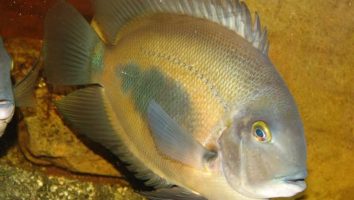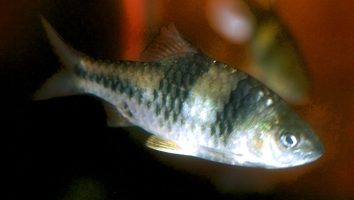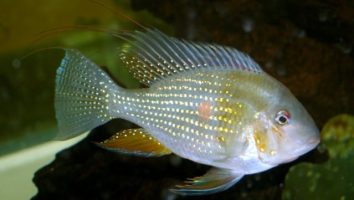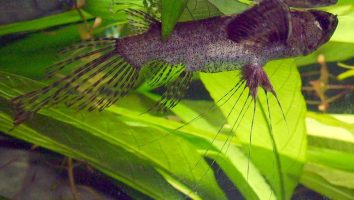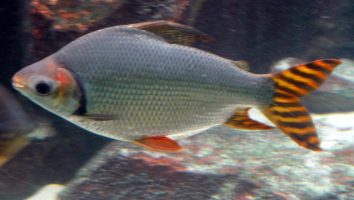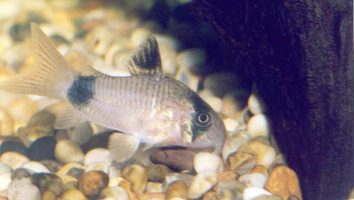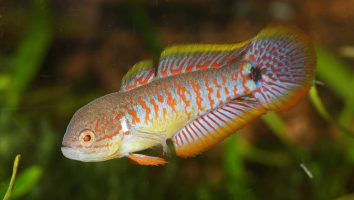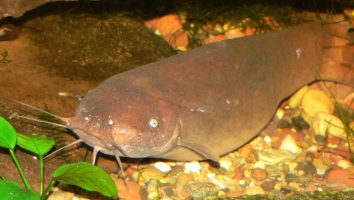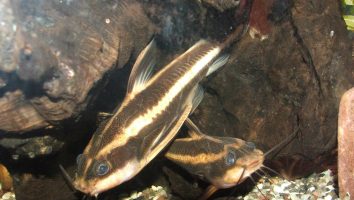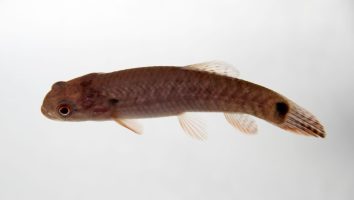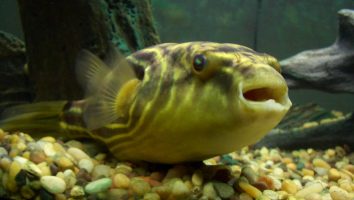The Mayan cichlid (Cichlasoma urophthalmus) is a beautiful freshwater fish that’s native to Central America.
This species is a great addition to any aquarium, and is relatively easy to care for. They’re also a very popular fish, which means they’re widely available.
If you’re thinking about getting a Mayan cichlid, this guide will teach you everything you need to know. We’ll cover topics like diet, tank mates, size, and more.
Table of contents
Species overview
The Mayan cichlid (scientific name: Amphilophus Mayanum) is a freshwater fish that’s native to Central America. It’s most commonly found in Guatemala, Belize, and parts of Mexico.
They prefer habitats with plenty of vegetation and hiding places. This could be in the form of plants, rocks, or even wood.
Mayan cichlids are Omnivores and their diet consists of both plant and animal matter. In the wild, they’ll eat things like algae, small insects, and crustaceans.
Mayan cichlids are a very popular choice for freshwater aquariums. They’re known for being peaceful, hardy, and relatively easy to care for.
Appearance
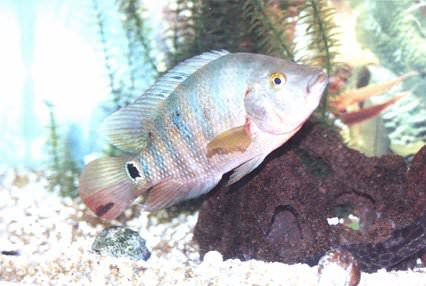
The Mayan cichlid is one of the most colorful freshwater fish in the world. They are a beautiful orange color with electric blue spots all over their body. The spots are more prominent on the males of the species.
The fins on the Mayan cichlid are also electric blue and they have a long and flowing dorsal fin and tail. The male Mayan cichlid also has a large nuchal hump on their head.
The Mayan cichlid is a large fish and can grow up to 18 inches in length. They are also a very aggressive fish and are not recommended for beginners.
Lifespan
The average lifespan of a Mayan cichlid is around 10 years. This is a pretty long time for a fish and it’s a testament to their hardiness.
Of course, there are a number of factors that can impact the lifespan of these fish. Poor water quality, for instance, can lead to a number of health problems that will shorten their life.
Stress from bad tank mates or a poor diet can also take years off their lifespan. In general, though, you can expect a Mayan cichlid to stick around for a good long while if you take good care of them.
Size
The Mayan cichlid is a large fish, with some specimens reaching up to 18 inches in length. However, the average size is more like 12 inches.
Tank
Tank Size
The minimum tank size for a Mayan cichlid is 50 gallons. This is assuming you’re only keeping one fish in the tank.
If you want to keep more than one cichlid, you’ll need to add at least 30 gallons for each additional fish.
Mayan cichlids are large fish and they need a lot of space to swim. They’re also very active fish and will often swim laps around the tank. If you don’t provide them with enough space, they can become stressed and this can lead to health problems.
Water Parameters
The Mayan cichlid is a freshwater fish that’s native to the Yucatan Peninsula in Mexico. In the wild, they inhabit rivers, lakes, and streams with a neutral to slightly alkaline pH.
They’re also used to water temperatures that range from the mid-70s to the low 80s.
In captivity, you can maintain similar water parameters to create a comfortable environment for your fish.
- Water temperature: 72 to 82 degrees Fahrenheit
- pH levels: 7.0 to 8.5
- Water hardness: 5 to 30 dGH
- Alkalinity Levels: 5-15 dKH
What To Put In Their Tank
When it comes to setting up the inside of an aquarium for a Mayan cichlid you need to be aware of a few things.
First, these fish love to dig. They’ll root around in the substrate looking for food, so you need to make sure it’s something that won’t hurt them. Sand or a very fine gravel is ideal.
Second, these fish are known to be territorial. They need a lot of space to themselves, so you need to make sure their tank is big enough. A good rule of thumb is to have at least 50 gallons per fish.
Third, they like hiding spots. Caves, rocks, and plants all make great places for them to hide. This will help reduce their stress levels and make them feel more comfortable in their environment.
Fourth, they need some open space to swim. Their tank shouldn’t be too cluttered, or they won’t have room to move around.
Keep all of these things in mind when setting up their tank and they’ll be sure to thrive!
Common Diseases
There are a few diseases that you should be aware of if you’re keeping Mayan cichlids. These fish are actually quite hardy, but poor water conditions can still lead to some problems.
The most common disease that these fish experience is ich. This is a parasitic infection that will present itself as white spots on the body, fins, and gills of your fish.
While ich is treatable, it can be quite difficult to get rid of. The best way to prevent it is by keeping your tank in pristine condition.
Another disease that these fish are susceptible to is hole-in-the-head disease. This is another water quality-related disease that will present itself as pits or holes in the skin of your fish’s head.
This disease is also treatable, but it can be quite difficult to get rid of. The best way to prevent it is by keeping your tank in pristine condition.
The last disease that we’ll mention is bacterial infection. This can affect any fish, but it’s especially common in Mayan cichlids.
This is usually caused by poor water quality and can present itself in a variety of ways. The most common symptom is cloudy eyes, but you may also see redness, swelling, and ulcers on the skin.
If you notice any of these symptoms, it’s important to act fast. Bacterial infections can be deadly if they’re not treated quickly.
Behavior & Temperament
The Mayan cichlid is a peaceful fish, but it can be aggressive if not kept with the right tank mates. These fish are known to be very territorial, so it’s important to give them plenty of space. They also need to be in a tank with other fish that can hold their own against the Mayan cichlid’s aggression.
Mayan cichlids are also known to be fin nippers. They may not eat the fins of other fish, but they will nip at them which can cause stress and injury.
Overall, the Mayan cichlid is a beautiful fish that can be a great addition to your tank. Just be sure to do your research and make sure you’re prepared for their aggression before adding them to your aquarium.
Tank Mates
The Mayan cichlid is a large and aggressive fish. As a result, it’s not the best candidate for a community tank. These fish are best kept alone or in pairs.
Mayan cichlids are also rather territorial. They’re known to set up shop in a particular area of the tank and defend it against all comers.
For these reasons, the best tank mates for Mayan cichlids are other large and aggressive fish. Species that are known to work well include:
Breeding
The Mayan cichlid is a beautiful fish that’s relatively easy to breed in captivity. These fish are native to freshwater lakes in Mexico and Guatemala. In the wild, they’re found in the waters around the Yucatan Peninsula.
Mayan cichlids are monogamous and form lifelong pairs. In the wild, they build nests out of rocks, plants, and other materials. The female lays her eggs in the nest, and the male guards them until they hatch.
To breed Mayan cichlids in captivity, you’ll need to set up a breeding tank. It should be at least 30 gallons in size. The tank should have plenty of hiding places and caves. live plants are also a good idea.
Mayan cichlids are territorial, so you’ll need to provide plenty of space. The more space you have, the better.
When setting up the tank, it’s important to create a gradient of temperatures. The water should be warmer at the bottom and cooler at the top. This will help trigger spawning.
Mayan cichlids are ready to breed when they’re about a year old. When they’re ready to spawn, the female will lay her eggs in a cave or other hiding place. The male will then guard the eggs until they hatch.
To increase the chances of successful spawning, you can add a piece of driftwood or a rock to the tank. The female will lay her eggs on this surface.
Once the eggs have been laid, you can remove the adults from the tank. The eggs will hatch in about three days.
The fry will be free-swimming in another week. At this point, you can start feeding them baby brine shrimp or other small foods.
Conclusion
The bottom line is that the Mayan cichlid is a great fish for experienced fish keepers. They’re not the easiest fish to take care of, but they’re definitely worth the effort.
If you’re looking for a fish that’s going to be a challenge, the Mayan cichlid is a great option. But if you’re just starting out, you might want to look for something a little easier.

